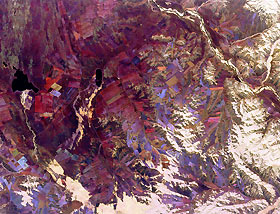
Save this image free of charge
in 800 pixels for layout use
(right click, Save as...)
|
|
Ref : V01981
Theme :
Looking at Earth - Cities (375 images)
Title : Space Radar Image of Tuva, Central Asia
Caption :
This spaceborne radar image shows part of the remote central Asian region of Tuva, an autonomous republic of the Russian Federation. Tuva is a mostly mountainous region that lies between western Mongolia and southern Siberia. This image shows the area just south of the republic's capital of Kyzyl. Most of the red, pink and blue areas in the image are agricultural fields of a large collective farming complex that was developed during the era of the Soviet Union. Traditional agricultural activity in the region, still active in remote areas, revolves around practices of nomadic livestock herding. White areas on the image are north-facing hillsides, which develop denser forests than south-facing slopes. The river in the upper right is one of the two major branches of the Yenesey River. Tuva has received some notoriety in recent years due to the intense interest of the celebrated Caltech physicist Dr. Richard Feynman, chronicled in the book 'Tuva or Bust' by Ralph Leighton.The image was acquired by Spaceborne Imaging Radar-C/X-Band Synthetic Aperture Radar (SIR-C/X-SAR) onboard the space shuttle Endeavour on October 1, 1994. The image is 56 kilometers by 74 kilometers (35 miles by 46 miles) and is centered at 51.5 degrees north latitude, 95.1 degrees east longitude. North is toward the upper right. The colors are assigned to different radar fequencies and polarizations of the radar as follows: red is L-band, horizontally transmitted and received; green is L-band, horizontally transmitted and vertically received; and blue is C-band, horizontally transmitted and vertically received. SIR-C/X-SAR, a joint mission of the German, Italian and United States space agencies, is part of NASA's Mission to Planet Earth program.
|
|

